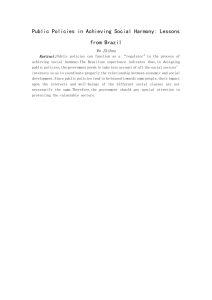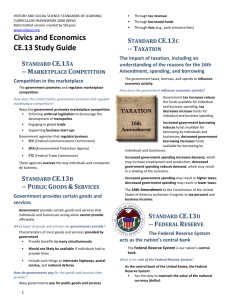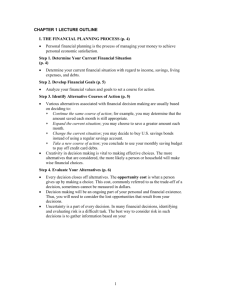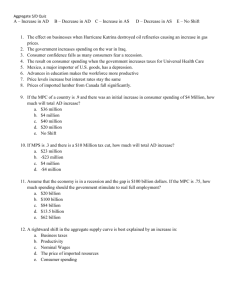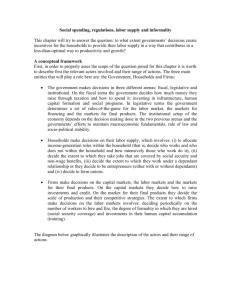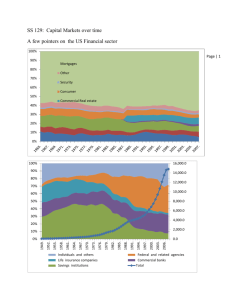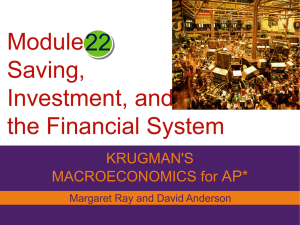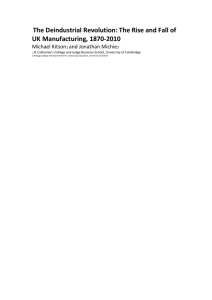Circular Flows - A Teaching Plan
advertisement
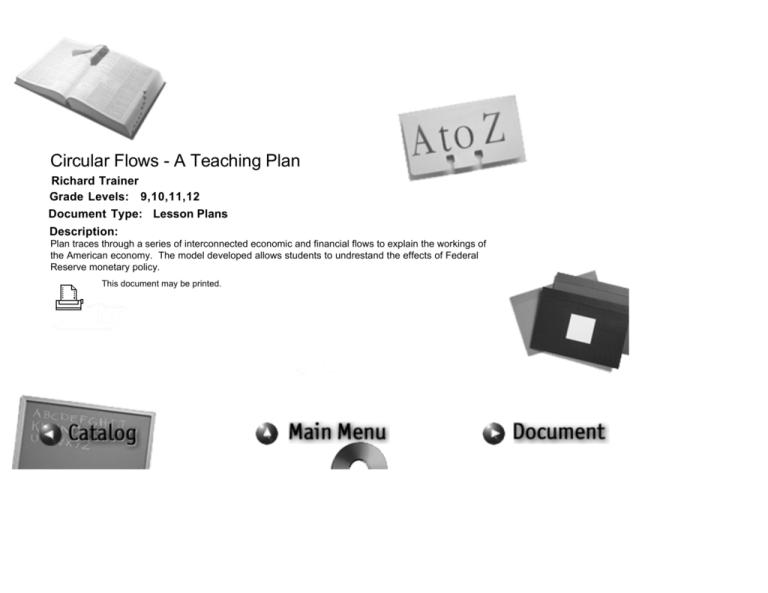
Circular Flows - A Teaching Plan Richard Trainer Grade Levels: 9,10,11,12 Document Type: Lesson Plans Description: Plan traces through a series of interconnected economic and financial flows to explain the workings of the American economy. The model developed allows students to undrestand the effects of Federal Reserve monetary policy. This document may be printed. The Circular Flows A Teaching Plan INTRODUCTION The United States is a multi-trillion dollar economy which annually allocates a staggering amount of resources to produce a variety of goods and services for domestic and world consumption, and provides employment and income for millions of individuals. Complex as it is, our economy can be more easily understood if it's pictured as a schematic of closely linked sectors––households, businesses, financial institutions, governments, foreigners and the Federal Reserve System. A change in a sector's economic or financial activity or in its transactions with another sector will trigger changes in the entire schematic until the economy takes on a different tone and tempo. To understand the ripple effects of economic and financial changes that routinely occur in an economy, economists have developed a model to explain the economy's flows. The Circular Flows teaching plan is designed for social studies and economics teachers. It is presented in three sections. Part I is the core of the plan and is presented in a double-column format. The left hand column provides a capsule summary of background information, concepts and definitions that are more fully explained in the right column. The summary column may be useful for those who either teach the circular flows as a single economics unit in a social studies curriculum or need only a quick review of the essentials. The right column will be useful for teachers who devote an entire term to economics or who are new to economics and want a structured, stepby-step analysis of the circular flows. Part II contains questions and exercises and is designed to assure that the learning objectives outlined below have been met. Suggested answers are provided. Part III contains three spirit duplicating masters of the circular flows model. Figures 1 and 2 show the six principal economic sectors in nine paired combinations; these can be used as student classroom worksheets. Figure 3 depicts the full model with all the sectors connected with flow arrows. Since the circular flows concept is one of the first classroom topics taught and uses a host of economic concepts developed in a full economics course, this teaching plan may be used as the centerpiece for a term course. However, it may be necessary to teach or review the essentials of demand and supply before beginning the circular flows program. Carefully review the program because it contains important information for you and your students and some pedagogical hints. Learning Objectives The Circular Flows is designed to allow social studies and economics students to participate with their teacher in a program about the structure and operation of our complex economic system. By tracing through a series of economic and financial activities, and related market transactions and exchanges, the program will enable students to do the following: • describe the several parts or sectors of the U.S. economic system and explain how each is related to the others; • explain how the flow of scarce economic resources primarily to business firms results in related flows of production, income, spending, borrowing, saving and taxes; • discuss the importance of households, businesses, governments and foreigners as the principal demanding or spending sectors; • discuss the role of savings as a major source of financing of the spending flows of households, businesses and governments; and • understand the effects of the Federal Reserve's monetary policy, and the fiscal policy of the administration and Congress on the circular flows and the economy's health and performance. The Program The program consists of the following: 1. six movable pieces printed on heavy stock paper; 2. a clear wax pencil; 3. a six inch flexible magnetized strip with an adhesive on one side; 4. three spirit duplicating masters (Part III); and 5. this teaching plan. Getting Started Before the classroom presentation, prepare each program piece. The selected method of preparation will depend on the classroom wall board surface that will be used. Either rub the backs of each piece with the wax pencil, or cut small one inch lengths of the magnetized strip, remove the cellophane backing and affix them to the backs of the pieces. Slate blackboards cleaned of all chalk dust will accept wax-backed pieces, while metallic boards will take the magnetic strips. Begin the program by discussing with the class the background information and the key concepts that are outlined below in Part I. It is essential that students understand these concepts before starting the mechanics of the circular flows. Emphasize the principal economic characteristics and activities of each of the six sectors. Also, mention that the circular flows model involves the full interaction of sectors, generally in markets, and that any change in one sector may trigger changes in other sectors. The model will allow students to trace the effects of these changes and to draw conclusions. Demonstrate the interdependence of the economic and financial activities of the sectors by connecting the sectors with hand-drawn arrows. For example, to show that the household sector supplies resources to the business sector, join the two sectors with an arrow labeled "RESOURCES." To show the payments by business firms to the household sector for the resources, connect the two sectors with another arrow labeled "MONEY PAYMENTS." Since the sectors will be connected with a number of arrows, using different colored chalk or felt tip marker pens may help avoid confusion. Suggestion: In depicting the flows between sectors, use only two sectors at a time. (You may wish to distribute to your students copies of Figures 1 and 2.) Begin the discussion of the circular flows by placing the household and business sector pieces on the board. After you have described the two sectors, draw the flows between them and instruct your students to do the same on their worksheets. Then, erase the connecting arrows and remove the two pieces. Place the household and the government sector pieces on a cleaned surface. As you describe the flows between the two by drawing the connecting arrows, instruct your students to enter on their worksheets the appropriate flow arrows. Again, clear the board and repeat the exercise until each sector's piece, paired with another, has been placed on the board, the related flows fully described, and the students have completed their worksheets. In the model developed in this program, there are nine pairs of sectors showing eighteen principal paired flows. Changes in the dollar levels as well as in the percentage or rates of change of economic or financial activity can be dramatized by altering the thickness of the handdrawn flow lines connecting the pieces on the classroom board surface. Also, by spreading the pieces over a larger board area, you can convey an expansion in the overall level of economic activity. A more compact array of pieces may be used to show an economic contraction. Suggestion: You may want to test the students' mastery of the circular flows once you have completed your classroom discussion and demonstration. Distribute copies of Figures 1 and 2 to the class. Select two students, each representing a sector, and ask them to explain the meaning and nature of the flows between the sectors they represent. When you are satisfied with their answers and are confident your class understands as well, instruct the class to enter and label the connecting arrows on the work sheets. Repeat this exercise for another two sectors, calling on another two students, until the model is completed. Suggestion: Rather than distributing copies of Figures 1 and 2, you may want to prepare the figures as overhead transparencies and project them on the classroom board. Call students to the front of the classroom. After they have correctly explained the bases for the flows, have them connect the sectors with flow arrows, properly labeled, using colored chalk or felt tip marker pens. After developing the flows on a sector-by-sector basis, and after you are satisfied your students have a reasonably good understanding of the model's separate parts and flows, place all six sectors on the board in the same general arrangement as they appear in Figure 3. Then, summarize the circular flows by drawing and labeling the arrows connecting all of the sectors. When you have finished, distribute copies of Figure 3 as an example of the completed model of the economy. PART I Background Because our economy is large and complex with innumerable parts linked in direct as well as indirect ways, it is necessary to develop a model to simplify matters. By setting aside the obscuring detail, a model will not only allow the student to appreciate how the economy actually works but also help them to understand what should be done by monetary and fiscal policymakers when the economy fails to achieve the generally accepted goals of high employment of productive resources, price stability, economic growth and balance in international transactions. As an abstraction from the "real world," a model is not intended to show each and every economic and financial activity and related flow; only the more significant ones are shown. Furthermore, a model shows activities and flows between sectors of the economy; with one exception involving business production of capital goods for other businesses, transactions that occur within the sectors are not shown. In addition, only economic and financial activities that generally occur in markets will be reflected in the model; barter transactions, illegal activities, cash transactions in the so-called "underground economy," and activities of weekend "do-it-yourselfers" are ignored. Finally, a model is intended to depict what is––however simplified that depiction may be. However, using an economic model to compare an economy's actual performance with the goals we would like to see an economy achieve is an extremely useful purpose of model building. The model developed in this program describes the U.S. economy as a series of separate yet related flows among six sectors. Generally, for every activity described, there is a real or physical flow and a related or counter money flow. For example, in exchange for a day's work (the flow of labor resources from individuals to businesses), workers receive a stream of money wages in connection with what they help produce. From this income flow, workers in their roles as consumers participate in related flows when they purchase goods and services from sellers and when they save. These flows spark additional flows such as tax payments to the government sector and borrowing from financial institutions. All of the economy's flows of financial and economic activities are related. When one or more of the flows is altered, the overall performance and health of the economy may change as well. For example, the economy's capacity to produce is measured by the stockpile of its productive resources and the manner in which it is used. If the economy's several sectors want to purchase more than the economy can currently produce with its resources, the general level of output prices may tend to rise as demanders compete for the available supply of goods and services. However, this excess demand for output may encourage producers to step up production by using existing resources more intensively, by acquiring new ones using their own accumulated financial resources, or by borrowing from the financial sector. Production costs may rise. As the economy begins to heat up with too much spending and rising prices and interest rates, fiscal policy (which involves the federal government's spending, taxation and borrowing programs) and monetary policy (which involves the Federal Reserve's influence over the availability of money and credit and their prices––interest rates––in financial markets) may be used to bring the various economic and financial flows back into balance. But before embarking on how public policy actually works to achieve an economic balance in the circular flows, we must first understand some key concepts. Key Concepts • Economic Resources The wealth of a nation is measured by its inventory of economic resources which consists of labor, raw materials, and physical or real capital. The value of a resource is reflected in its price which, in turn, reflects its contribution to the production of goods and services, namely its productivity. As the quantity and quality of a nation's resources expand, so does its potential to produce. ■ Labor is either the manual or mental activity of individuals that contributes to the production of goods and services. The stockpile of a nation's labor resources along with its skills and talents is sometimes referred to as its human capital. The principal flows of labor services occur between the household sector and the business and government sectors. A farmer harvesting a crop and an apprentice mason plying her trade are just as much a part of the economy's labor resource stock as is an experienced teacher spending time writing a lesson for an economics class. The definition of labor resources is broad enough to include management whose principal function is to assume risk by acquiring, organizing and combining resources to produce output. The productive quality of labor can be enhanced with formal education, new skills learned on the job, or by equipping workers with better tools, machinery or computers. Over time, the size of the labor stock grows with an increase in the number of working age people. ■ Raw materials or natural resources––often referred to as "land"––consist of the bounty of nature which is above, on and below the earth's surface. Air, rivers and timber lands, and ore lodes in mines are some examples. In addition to natural resources, raw materials also include the materials synthesized from natural resources that may be used in further production; plastic is an example. The quantity of raw materials may grow with discoveries of new reserves of known resources or of entirely new raw materials; with a more intensive exploitation of existing resource reserves; with technological change; and with resources imported from abroad. ■ Physical or real capital is defined as manufactured goods (such as a mason's trowel or a complex super computer) the services of which are used to produce other goods and services. The stockpile of real capital goods includes equipment and factories, and business inventories of semi-finished goods that need additional processing before being sold. The quality of the capital stock grows with business expenditures on research and development and the resultant adoption of new production technologies. When combined with the services of labor and raw materials, real capital also contributes to the production of goods and services. The greatest toll on a nation's resource base occurs over time as its resources are being used in production. The ability and capacity of businesses and the economy to produce are impaired as capital goods age and wear down, as raw materials are depleted, or in the face of advancing technology, as some capital becomes obsolete. Normally, the level of business spending annually on new capital goods is sufficient to offset wear and tear and technological obsolescence. The nation's real capital stock grows with business investment spending. Business firms finance capital spending with their own funds as well as with those borrowed in financial markets. There are sufficient incentives in our economic system, namely the lure of profits and the aversion to losses, for business firms to make provisions for increasing the quantity and productivity of resources. Investment spending is essential to physically replace the capital goods that have worn out from productive use as well as to add to the capital stock beyond the amount replaced. Generally, investment spending occurs within the business sector when some business firms use resources to produce capital goods for other businesses that, in turn, use them to produce consumer goods and services. If what business firms spend for new capital resources is only sufficient to replace the tools, machines and factories that wear out or become obsolete, the nation's net real capital stockpile will generally remain unchanged. However, if business investment spending is less than wear and tear and technological obsolescence, the capital stock will, on balance, decline. This happened at the lowest point in the Great Depression in 1933. Finally, if business spending on new capital resources is greater than the amount that has worn out or becomes obsolete, the nation's capital stock will grow on balance, thereby expanding the productive capacity of the economy. • Gross National Product An economy's gross national product or GNP is an estimate of the total market value of the final goods and services produced in a year. GNP is a widely used barometer of the economy's health and performance. Knowing the value of an economy's GNP is not an assurance that its resources are fully employed. If the resource stockpile is not fully employed, an economy will produce an amount less than its potential. The real cost of idle resources, then, is the amount of potential output not produced. GNP includes only the value of final output produced. The value of intermediate output (say, wheat) that itself is used to produce a final or finished product (a loaf of bread) is not included in the value of GNP. Since the value or cost of intermediate production is included in the value or price of the final product, counting the value of everything produced (the market value of wheat which will become bread and the value of bread) would vastly overstate the dollar value of production. Most of the value of GNP reflects, in large part, the costs associated with employing resources to produce goods and services. And since the cost of resources to business firms represents income to resource suppliers, the value of a nation's GNP also reflects the level of its income in the form of wages, salaries, rent, interest, dividends and profits. The prices used to measure the market value of an economy's GNP are those prevailing during the year in which the output is produced, i.e. at "current year" prices. The market value of a subsequent year's GNP may change with changes in the physical amount produced and/or the market prices at which output is sold. To eliminate the distorting effects of changing prices on the valuation of GNP, a price index is used. A price index uses a base or reference year price level which standardizes the value, but not the physical quantity, of output produced over a period of time. The result of adjusting a current year's GNP for the effects of rising prices is called real GNP––the GNP of a given year whose value is measured in terms of prices prevailing in the base year. Another way of looking at GNP is to measure the total amount of spending by each economic sector for a share of the total amount produced. The principal spending sectors in our model are households, business firms, governments and foreigners. Generally, all that an economy produces is available for domestic use. However, since nations trade with each other, the total amount produced in an economy may not necessarily be the same as the amount available domestically. The amount of an economy's GNP that is exported reduces the amount available for domestic consumption, while the amount imported––produced by other economies––expands the amount available for domestic consumption. From a spending point of view, an economy can consume either less or more than it has produced by exporting or importing the difference. • Markets ■ Generally, activities of the economy's sectors, as well as the interaction among them, take place in markets. A market exists where a buyer and a seller voluntarily exchange "something" for an agreed upon price. Economic resources, goods and services as well as money and credit are some examples of the things that are exchanged at various prices in a variety of markets. Normally, when markets are allowed to operate free of government and private monopoly interference, the well-being of society is generally enhanced. However, when markets fail to allocate resources to produce goods and services society wants and needs, government intervention in the form of spending or taxation may be required. Markets are defined not only by their physical dimensions but also by the functions they perform. Markets may be local, regional, national and international; the participants may be two, few or many. (By definition, markets consist of two "sides": demand and supply. One "side" without the other will not make a market.) Some markets are highly regulated by government agencies, while others are competitive where the forces of market demand and supply determine prices and the amounts exchanged. Some markets exist only where buyers and sellers meet face-to-face, such as at a local flea market, while in others participants are linked by telephone or other electronic devices, such as in the government securities market. Markets facilitate the transfer of goods and services as well as economic and financial resources such as money and credit between buyers and sellers. Generally, individuals will not voluntarily enter into a market exchange unless they perceive an improvement in their well-being. For example, unless a buyer sees herself as being better off after purchasing a commodity than with holding the cash used to purchase it, the transaction will generally not occur. In addition, markets permit a more efficient use of society's resources. For example, an individual can specialize in doing that for which he or she is best suited and with the wages earned purchase more than had there been no specialization. The Sectors The model consists of six sectors (households, businesses, governments, financial institutions, foreigners and the Federal Reserve System) and the paired flows between them. The circular flows model involves the full interaction of sectors, usually in markets; changes in one sector will generally trigger changes in other sectors. For each economic transaction, there is both a demand and a supply dimension. For example, the household sector supplies resources to the business sector which demands them to produce goods and services. Similarly, the business sector supplies the output produced to households, governments and foreigners––the demanding sectors. These supply and demand dimensions also apply to financial transactions. For example, when the federal government borrows, its demand for funds is reflected in its sale (supply) of IOUs called government securities. Similarly, when individuals save they supply funds by demanding, in return, financial assets such as government IOUs. The Household Sector In a private property system such as ours, the stockpile of resources is owned either directly by individuals, or indirectly by them as shareholders of businesses. As resource suppliers, individuals earn money income (wages and salaries, interest, rent and dividends). Individuals may also receive income––called transfer payments– –that is unrelated to their current role as resource suppliers. Examples include veterans' benefits, welfare payments, and retirement or pension benefits related to their former role as resource suppliers. Household income, along with borrowings from financial markets, is spent on goods (such as automobiles and food) and services (such as education and entertainment). Households also pay taxes and save. The portion of household income that is neither spent nor taxed is saved. Individuals are motivated to save for a variety of reasons. For example, while earning income, individuals may want to spend a little less now by saving so they can have a little more later for such things as retirement, their children's (or their own) education, or contingencies. An added inducement to save is the reward savers expect to receive––a monetary return on the amount saved as measured by the rate of interest. Since individuals would generally prefer to spend and consume more now than later, the amount of interest earned is, in a sense, a form of compensation savers require for postponing consumption. Today, savers have a variety of ways in which to store their savings. These include passbook savings deposits at banks and thrift institutions; contributions to retirement or pension funds; government and corporate bonds; and corporate stocks. Most of the savings of individuals (as well as that of the other sectors) are channeled through financial markets by financial institutions called intermediaries. Only a small fraction of savings flows directly from those sectors that save to those that borrow. While the bulk of their income is spent, households, like the other sectors, often borrow to purchase goods and services the cost of which may be beyond the reach of their current incomes. Examples of financed consumption include purchases of automobiles, homes and education. Of course, consumers may, as a matter of convenience, borrow when they use credit or charge cards to purchase relatively less expensive times such as food in restaurants or clothing. Finally, individuals pay taxes on the basis of their income, on the things they purchase or on the property they own. The taxes collected represent the principal source of income to the government sector. By changing the rate of taxation and/or the base on which it is applied, the government sector can affect the level of household disposable (after-tax) income that is available for spending and saving. The individuals in this sector perform several key economic functions that are depicted by six paired flows with other sectors. First, individuals supply resources to and receive income from the business sector. Second, they supply resources to and receive income from the government sector. Third, they spend money to purchase goods and services produced by the business sector. Fourth, individuals pay taxes and fees to the government sector in exchange for certain, i.e. "public," goods and services that are generally not produced by the private sector. The fifth and sixth paired flows involve individuals borrowing funds from financial institutions as well as placing some of their after-tax income as saving with financial institutions. The Business Sector The principal economic activity of the business sector is the production of services as well as consumer and capital goods. Consumer goods and services include television sets, clothing and health care that are bought for immediate consumption. Capital goods include trucks, tools and equipment which, while not directly consumed, are used to produce either additional consumer goods and services or capital goods. Firms producing capital goods contribute to the economy's stockpile of capital resources. As producers, firms compete with each other in the resource markets when acquiring, primarily from the household sector, the economy's limited amount of economic resources. The cost of acquiring resources such as labor is a source of income (namely, wages) for households, the labor resource suppliers. Often we think of production only in physical terms––a field, furrowed and seeded, combined with water, fertilizer, tractors and labor will, after a period of time, yield a certain amount of corn. Similarly, mixing the right proportions of iron ore, coke, electricity, furnaces, mills and labor results in the output of steel. Services are also part of the production activities of business firms. The shipment of an automobile from an assembly plant to a dealer's showroom involves the production of transportation services. In our economic system, profit prospects and the fear of loss or failure are incentives for business firms to acquire relatively scarce and costly resources and combine them with the best available technology to produce at the least possible cost and sell at a competitive price. Market competition by businesses for resources and by consumers for output generally assures these results. Business firms come wrapped in various legal packages such as corporations, partnerships and sole proprietorships. While business corporations are far fewer in number than the other legal forms of business organization, they nevertheless account for the bulk of production of goods and services, resource employment, and borrowing in financial markets. A reason for the importance of the corporate form of business organization is that losses to shareholders are generally limited to the size of their financial investment while the other forms of organization do not offer such protection. A firm's net income or profit is the difference between its revenue from selling output and the costs or expenses associated with producing it. Net income is either distributed by the firm as dividends to its shareholders or retained as undistributed profits, which represent business saving. These profits are an important internal source of funds firms use to finance their expenditures for new capital resources or to place in financial intermediaries for use by others. In addition to undistributed profits, funds borrowed in financial markets are also used to finance business expenditures. Borrowings represent an external source of funds for businesses. When firms borrow, they compete with each other as well as with other sectors for the relatively limited amount of funds that savers have poured into financial markets. Like other borrowers, business firms generally borrow by exchanging their promises (or IOUs) to repay on a specified schedule, not only the original amount borrowed but interest as well. Incorporated firms also raise funds by selling stock (ownership certificates) or bonds to the public. Businesses borrow for short periods of time when their flow of income from selling output is temporarily less than production-related costs and other expenses. For example, retail automobile dealers usually maintain an inventory of automobiles in their showrooms. Dealers generally borrow funds from banks to cover the costs associated with maintaining these inventories. The loans are usually repaid with the revenues earned when the inventory is finally sold to customers. In addition to borrowing when income is temporarily out of sync with expenditures, firms raise funds for longer periods of time by selling bonds and stocks to finance their investment spending plans. A firm undertakes relatively costly capital projects because they are expected to enhance its productive capacity. Increasing output will normally produce a stream of future income or revenue. It is from these expected future income flows that the firm's costs of borrowing are normally met. Changes in the business sector's level of capital investment spending are an important cause of expansions and contractions in the general level of economic activity, namely in production, income, employment and prices. Business investment spending is affected by a variety of factors including the current and expected state of the economy, interest rates, and taxes. An economic slowdown that is expected to continue for some time may result in business firms trimming their capital spending plans. Borrowing to acquire machinery to produce goods and services for which demand is slowing would not be an economically wise decision. Firms would not only find themselves with excess or idle production capacity, but they would also find it more difficult to meet borrowing costs from a slower flow of income. Similarly, rising interest rates might lead firms to reconsider spending plans, especially when the cost of borrowing exceeds the return they expect on particular business investments. A sluggish economy, high business taxes and rising interest rates normally impair the rate of business investment spending and, in turn, the economy's capacity to grow and produce goods and services. The economy's associated flows of income to resource owners, spending, saving and taxes also slow. In contrast, an expanding economy, along with a favorable tax and interest rate environment, will cause the circular flows of economic and financial activity to expand as well. The key players in this sector are business firms. The sector's activities are depicted by eight paired flows. First, in exchange for relatively scarce and costly resources, business firms make resource payments to the household sector. The second, third and fourth paired flows involve business firms, using purchased resources, producing output in exchange form money payments from the household, government and foreign sectors. Fifth, businesses pay taxes to the government sector in exchange for public goods and services. Sixth, domestic businesses make payments to the foreign sector for imports of goods, services and resources. Seventh, firms with production costs less than revenue save by diverting the difference––called retained earnings––to financial institutions. And eighth, firms often borrow in financial markets to meet short-term spending needs as well as to finance long-term capital expenditure projects. These eight flows occur between sectors in the model. An important flow (not depicted) that takes place within the business sector involves business investment spending for capital goods produced by other businesses. The Public or Government Sector The spending of the public sector is for the output of goods and services produced by private sector business firms. For example, the federal government provides national defense using aircraft carriers produced by and purchased from the private sector. Similarly, states hire private construction companies to build new highways. However, by purchasing resources from households, governments may actually produce output directly (rather than acquire it through private enterprise) for distribution. Examples include municipal water companies, toll bridges and public education. Whether the public sector acquires privately produced goods and services for distribution or produces the output itself, government spending as well as government taxation results in the public sector's claim over a portion of society's relatively scarce economic resources that are, therefore, not available for private use and private production. As a rule, the government sector provides the private sector with goods and services that the market generally does not or cannot provide. For example, private business firms generally will not provide goods and services to customers who do not pay yet benefit from their availability. If such goods and services are provided at all, it is generally done by the public sector. They are called public or collective goods and services because individuals "collectively" benefit from their availability whether or not they pay. National defense is an example of a collective service provided by the federal government. A change in the level of government spending affects the economy's flows. If the government sector were to step up its demand for goods and services produced by businesses, resource employment would increase as would the levels of household and business income, spending and saving. Tax receipts may even rise without a change in tax rates as households and businesses pay more taxes on higher incomes. As with a reduction in taxes, an increase in government spending will generally stimulate the tempo of economic activity and the associated flows. Similarly, a slowing or reduction in government spending (or an increase in taxes) would tend to slow the economy's flows as well. An important fiscal function of the federal government is to stabilize the economy's private spending and production flows to avoid too rapid or too slow a growth in the economy, price instability and unemployment. The federal government contributes to the stability of the economy when the level of its spending runs counter to the level of economic activity. For example, as the economy turns down with a slowing in the flows of production and consumption, a deliberate increase in federal government spending and/or a decrease in taxation will tend to stimulate the economy's flows. However, when the economy is expanding rapidly, a deliberate reduction or slowing of government spending and/or increase in taxes work to slow the economy's flows. Not all federal spending moves in a direction opposite to that of the economy. Some programs, such as national defense, social security benefits and transfer payments, and interest payments on past government borrowing, tend to grow unrelated to the cyclical swings in the economy. These government outlays have become an increasingly important part of the federal budget. The principal source of revenue for the federal government comes from taxes levied on the income of households and businesses. State and local governments, however, rely to a large extent on sales and real estate taxes. A tax on the flow of income affects the amount households and business firms devote to saving as well as to spending on services and consumer and business capital investment goods. For example, an increase in the personal income tax rate would tend to lower after-tax or disposable income and, in turn, the amount of income households allocate to spending and saving. With higher taxes discouraging consumer spending, business firms will generally cut back on production rather than being stuck with unsold inventories of output. A slowing in production will decrease business demand for productive resources and, in turn, will increase resource unemployment and lower resource income, further reducing the general demand for goods and services, which was initially triggered by the income tax increase. The federal government has generally operated with a budget deficit. Deficits occur when the growth of federal spending exceeds that of tax collections. Generally, during an economic expansion, government spending tends to slow while tax collections tend to rise. The result: either the deficit becomes smaller or a surplus becomes larger. Similarly, during an economic contraction, the federal deficit tends to grow as tax collections slow while spending on recession-related programs rises. Borrowing is required as a normal part of state and municipal public finance to meet day-to-day expenditures, which often exceed the flow of tax collections, as well as to finance large and expensive public programs such as bridge and school construction. On balance, however, state and municipal governments generally save, that is, they show budget surpluses Lumped together in this sector are all levels of government––federal, state, municipal and local. The sector includes more than 80.000 separate units. The sector's activities are depicted by six paired flows. There are two similar flows between the public sector and each of the household and business sectors when goods and services generally not provided by the private sector are provided indirectly in exchange for the payment of taxes. A third flow is depicted by the public sector's purchase of resources from the household sector in exchange for money payments. Fourth, the public sector purchases goods and services produced by the private business sector. The fifth flow occurs when the sector sells its IOUs in exchange for funds borrowed primarily through financial intermediaries in financial markets. The sixth flow is that of saving into financial markets when the public sector, particularly state and local governments, shows a budget surplus when taxes exceed expenditures. The federal government occupies a unique place in the circular flows model. As the largest single governmental unit, it exerts a tremendous influence over the economy's real and financial flows. Through changes in the tax structure, the composition and level of its spending, and the amount it borrows in financial markets, the federal government's fiscal policy directly affects the flows of economic and financial activity and, in turn, the state of the economy. The Foreign Sector The trade flows between the U.S. and the rest of the world include our exports and imports of consumer and capital goods as well as services. Capital goods include machinery and tools, while services include tourism and commercial shipping. A nation is said to "pay" for its imports with the funds received from its exports. This is similar to saying that a household pays for its expenditures on goods and services with the wages it receives as a labor resource supplier. And, like the household that must borrow if it wants to spend more than its income, so must a nation if it wants to buy more in imports than it sells as exports. International payments are more complicated. Consumers of imports usually buy them with their own currency. However, the resource suppliers of the exporting country want to be paid in the currency of their own country. So at some point, the currency of the importing country must be traded or exchanged for that of the exporting country. This currency trade is done in the foreign exchange market, where currencies are actively bought and sold. Also, international bank lending and purchases of a variety of financial securities or IOUs require changing one currency into another in the foreign exchange market. The value of a country's currency in terms of other currencies is determined in the foreign exchange market. A country's foreign exchange value reflects the international flows of funds between countries. For example, the supply of a country's currency in the foreign exchange market will normally increase (with all other factors given, its exchange value will fall) when the level of its imports or its international lending rises. Conversely, the demand for a country's currency will normally increase (with all other factors given, its exchange value will rise) when the level of its exports or its borrowings from other countries rise. Changes in the exchange value of a country's currency can affect the economic and financial flows within the country. Increases in the exchange value of a country's currency will tend to reduce or slow its exports while increasing its demand for imports. In addition, with a rise in a country's exchange value, the demand for resources by its exporting industries will tend to fall, with related declines in the level of income. Conversely, when the value of a country's currency falls, its domestic production of goods and services for export will be stimulated while its import demand will slow or decrease. In addition, the country's levels of resource employment and income will tend to increase. Together, the trade of goods and services and the movement of funds between the U.S. and the rest of the world affect the state of the domestic economy as well as that of other nations. The activities of this sector are reflected in four principal paired flows. The first two involve the trade flows of exports and imports of goods and services in exchange for money payments. The second two flows involve the financial flows of lending and borrowing, and the related exchanges of financial IOUs. These four flows occur between businesses and financial institutions in the United States and those in other economies, i.e. "the rest of the world." Not shown are official transactions between the U.S. and the rest of the world; for example, federal government foreign aid. As an economy's window to the world, the foreign sector permits domestic economic and financial factors to influence other economies. And, of course, economic and financial developments in the rest of the world are transmitted through the foreign sector to our economy. The Financial Sector Generally, households, business firms, governments and the foreign sector borrow as well as save. What is important, however, is what a sector does on balance. Those that save more than borrow are called surplus funds sectors; they contribute more to the nation's pool of savings than they withdraw from it. Surplus funds sectors usually include households, and state and local governments. Sectors that borrow more than save are deficit funds sectors; they take more from the savings pool than they contribute. These sectors usually include business firms and the federal government. A surplus funds sector contributes or adds to the savings pool by acquiring an IOU or liability of a borrower for money. The IOU, an asset or something valuable to the saver, represents an amount lent as well as the borrower's promise to repay that sum with interest. The flip side of the same transaction involves the borrower selling an IOU to a saver in exchange for money. The creation of the debt withdraws funds from the pool savers have provided. In other words, saving and borrowing are but opposite sides of the same coin: an increase in the amount of financial obligations or borrowings is matched at a particular level of interest rates by an equal increase in financial assets or saving. Generally, household saving, like the saving of the other sectors, flows through financial institutions which, in turn, make the funds available to other borrowers. Only a small portion of funds flow directly from savers to ultimate borrowers. The household sector is the largest single saving sector. On balance, it saves more than it borrows. Its contributions to the savings pool take several forms: • • • deposits to a variety of accounts held at banks and thrifts; purchases of federal, state and municipal government securities; purchases of corporate stocks and bonds; • • purchases of life insurance policies; and contributions to pension or retirement funds. Savings play a critical role in the economy's circular flows. The year's accumulation of savings from households and state and local governments represents the amount of income from productive activity that is not spent. From this accumulation or pool of funds claims are made by the borrowing sectors for funds to finance their expenditures. The supply of funds from savers always equals the demand for funds by borrowers at a given level of interest rates. If the demand for funds were temporarily greater than supply, competition among borrowers for the relatively limited supply would bid up the prices––interest rates––of funds. Higher interest rates would generally encourage more saving while discouraging some borrowing until demand and supply were again balanced at a new level of interest rates. For example, when the economy is rapidly expanding, households and business firms generally step up their borrowing to finance increasing amounts of their spending on services as well as on consumer and capital goods. Increased competition by borrowers for a share of the available pool of savings will tend to push up interest rates. If the federal government is also borrowing to finance a budget deficit, there will tend to be further upward pressure on interest rates in financial markets. And rising interest rates will tend to slow the flows of spending and production. Of all the financial institutions, banks and thrifts are singularly important in the circular flows model for two reasons: • • They hold the funds of the other sectors in the form of deposits that are used to make payments for purchases of goods and services. These deposits––called checking accounts––comprise nearly three-quarters of the nation's basic supply of money. (The balance is held in the form of coins and paper currency.) None of the other financial institutions possess the deposit-taking power of banks and thrifts. They create new checkbook deposit money when they make loans to borrowers to finance spending on goods and services. The ability of banks and thrifts to extend credit to borrowers is limited by the amount of reserves they have on hand. Banks and thrifts obtain their funds primarily by taking checking and savings accounts from the other sectors. The amount of deposit funds held by these deposit-taking institutions changes as checking deposits move about in the banking system. Sectors receiving payments deposit funds and those making payments withdraw funds from banks and thrifts. Banks receiving new deposits from their customers are able to make more loans, while those losing deposits can make fewer loans. The players in this sector include commercial banks and thrift institutions, insurance companies, pension funds, and securities firms. The bulk of saving and borrowing occurs through financial institutions. There are ten principal flows describing the activities of this sector. The first three flows represent the saving flows of the household, business and public sectors (especially state and local governments). There are also three flows representing the borrowings of the household, business and public sectors (especially the federal government). There are two flows of lending and borrowing that routinely occur between U.S. financial markets and those abroad. Finally, perhaps among the more important flows are those of reserves into and out of the banking system triggered by monetary policy actions of the Federal Reserve. To a large extent, it is the ebb and flow of funds, and the related exchanges in financial IOUs, between the borrowing and saving sectors that affect the cost of funds––interest rates. Key to the performance of an economy is how well the financial sector functions in allocating funds between savers and borrowers. Financial institutions contribute importantly to the continued flows of real economic activity as borrowed funds are spent to acquire goods and services. And as spending stimulates the flow of production, the levels of resource employment, income, consumption, saving and taxes generally rises as well. Of all the financial institutions, banks and thrifts are particularly important. Not only are they a major source of credit for the borrowing sectors but they also hold funds in a form that all sectors use to make payments related to the flows of production and consumption of goods, services and resources. The Federal Reserve System Congress chose to delegate its Constitutional power contained in Article 1, Section 8– –"The Congress shall have the power to coin money [and] regulate [its] value..."––to an independent agency when it created the Federal Reserve System in 1913. While the Federal Reserve does not actually coin money, it does provide the supply of paper money called Federal Reserve notes. However, its most important monetary power is to create a special type of "money" (that only it is empowered to create) called reserves. By providing more or fewer reserves through monetary policy actions, the Federal Reserve affects the money and credit creating abilities of banks and thrift institutions in the financial sector. Money and credit are important factors that help determine the levels and flows of economic activity. When deposit taking institutions such as banks and thrifts make loans to households and business firms or purchase newly-issued government securities, checkbook money is generally created. The Federal Reserve uses three principal tools to affect the banking system's reserves and its ability to create new checkbook money: open market purchases and sales of federal government securities; changes in reserve requirements; and changes in the discount rate. Of the three tools, open market operations in government securities is the most frequently used. By buying government securities from private government securities dealers, the Federal Reserve pays by writing checks on itself. When dealers deposit these checks into their checking accounts at banks, two things happen: • The money supply is increased by the amount of the dealers' deposits. Note: remember, checking accounts are a major part of our supply of money. Make certain your students understand that the deposit of a Federal Reserve check is neu' money that didn't exist before the Federal Reserve's open market purchase of securities from dealers. Contrast this with what happens when, for example, a tenant writes a check on her checking account to pay for a month's rent. When the • check clears, the tenant's checking account decreases while the landlord's checking account increases. On balance, the supply of checkbook money has not changed. By using a checking account, existing funds in the economy are simply recycled or transferred from one person to another. But when the Federal Reserve writes a check, neu' checkbook money is created. The banks into which the securities dealers deposit their Federal Reserve checks receive new funds or reserves that did not exist in the banking system before the Federal Reserve's open market purchase. Banks and thrifts are required by law to set aside a fixed fraction of reserves against new deposits. These "set asides" are called required reserves. The difference between a bank's total reserves and its required reserves is called excess reserves, which it uses to make loans to consumers and businesses or to purchase securities. When banks and thrifts make loans or purchase investment securities on the basis of their excess reserves, new checkbook money is usually created. For example, when a bank makes a loan, it merely takes the borrower's IOU (the promise to repay the loan with interest) and credits the borrower's checking account with the amount of the loan. (For an elaboration of checking deposit creation and contraction by the banking system, see Making Money in Middlevillage, a teaching plan available free of charge from the Federal Reserve Bank of New York.) As the nation's central bank, the Federal Reserve is empowered by Congress through monetary policy actions to regulate the supply of funds that flow through financial markets. In addition, while there are a variety of factors, monetary policy is one of the more important ones affecting the price of funds, namely the level of interest rates. In the short term, the Federal Reserve's monetary policy actions directly influence financial markets and depository institutions as well as each sector's decisions to save and borrow. Over time, however, monetary policy actions filter through financial markets and affect the economy generally, i.e. the levels and flows of production of goods and services; resource employment; household and business income and spending; interest rates; international trade and financial flows; the level of prices; the flow of saving; and taxation. PART II Questions and Answers 1. Question: What is an economic model? Answer: Like the circular flows model developed in the program, a model is a simplified description of the real world. 2. Question: What are the four principal economic goals of monetary and fiscal policy? Answer: The goals are high employment of economic resources, price stability, economic growth, and balance in international transactions. 3. Question: If the nominal or market value of last year's GNP equaled $100 (billion), while this year's equals $112 (billion), what is the value of this year's GNP using last year's––the base year's––prices? Assume that output prices generally have risen by 5%. Answer: This year's nominal GNP is 12% greater than last year's. (Subtract $100 from $112 and divide by $100 to obtain 0.12 or 12%.) However, since prices have risen by 5%, this year's real or price-adjusted GNP is only 7% higher than last year's, or $107 (billion). In other words, the percent change in nominal GNP minus the percent change in prices equals the percent change in real GNP. 4. Question: Is the money earned by a miser and placed under a mattress a form of saving? Answer: While hoarding reduces the miser's spendable income and, therefore, this demand for goods and services, it is not the type of saving we are talking about. Placing income earned from a productive activity under a mattress effectively removes it from use by others, namely by borrowers. So, the miser's income produced from productive activity does not return to productive activity, thereby breaking one of the more important flows in our model. Fortunately, most of us are not likely to hoard and forego an interest return on our savings. 5. Question: What happens to the premiums and pension contributions collected, i.e. "borrowed", from individuals by insurance companies and retirement plans? Answer: Like the deposits at banks, insurance premiums and pension contributions are used by financial institutions to purchase the IOUs of businesses and governments. In other words. the savings of households are channeled through financial institutions to such ultimate borrowers as business firms and governments. 6. Question: Why are depository institutions––banks and thrifts––important in the circular flows model? Answer: Banks and thrifts are important not only as major providers of credit to the borrowing sectors but also as depositories of funds (checkbook money or checking accounts) that are used to make payments for goods and services. 7. Question: Suppose there are only two countries in the world economy: the United States and England. Let the dollar's foreign exchange value appreciate against the pound sterling: initially, 1 dollar exchanged for 2 pounds, but now 1 dollar can buy 4 pounds. (Alternatively, 1 pound exchanged for one-half of a dollar, but now it can only buy twenty five cents.) What is likely to happen to: (1) U.S. exports, (2) U.S. imports, (3) the level of U.S. gross national product, and (4) resource employment in U.S. export and import sectors? Repeat the exercise by looking at the economic impact on England. Answer: U.S. exports, GNP and employment in the export sector would fall, while imports and employment in the import sector would increase. 8. Question: What are the effects of foreigners depositing their money in U.S. financial institutions or purchasing the securities of American business firms and governments? Answer: Foreign financial investments in U.S. markets, in effect, remove savings from foreign countries and make them available to American consumers, business firms, governments and financial institutions. 9. Question: What are the effects of the Federal Reserve's open market sale of government securities to dealers? Answer: Securities dealers pay for the securities sold by the Federal Reserve by writing checks against their bank deposit accounts. As a result, the supply of checkbook money and bank reserves decrease. And with fewer reserves, the banking system as a whole is less able to make loans and purchase investments, slowing the growth of the supply of money. 10. Question: The Federal Reserve through open market operations affects the price, i.e. the level of interest rates, and the quantity of funds in financial markets. How do the other sectors influence the level of interest rates? Answer: Competition by borrowers for the available pool of funds savers have provided through financial institutions affects interest rates in financial markets. PART III The Business Sector The Household Sector The Federal Reserve System The Public or Government Sector The Financial Sector The Foreign Sector PART III Figure 1 PART III Figure 2

